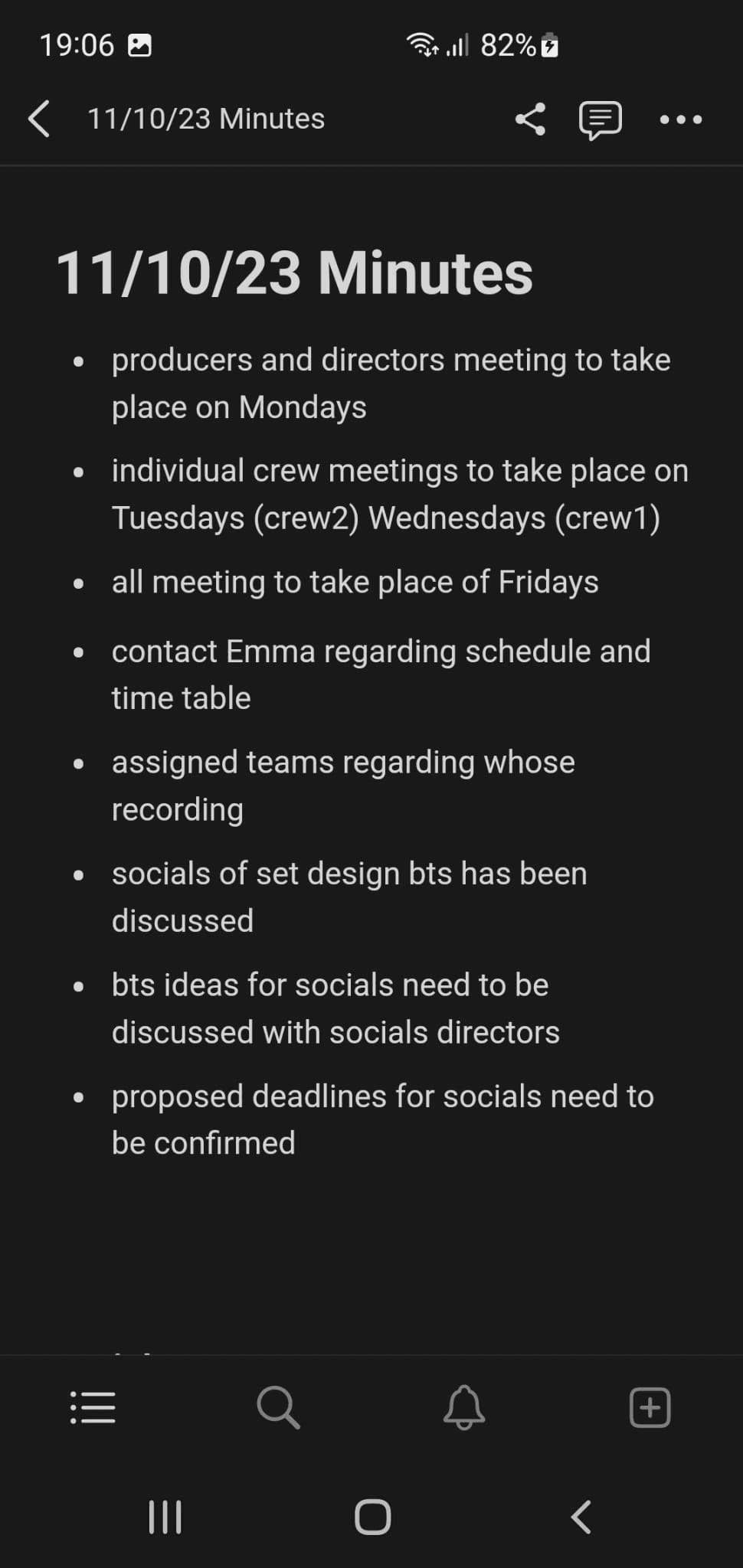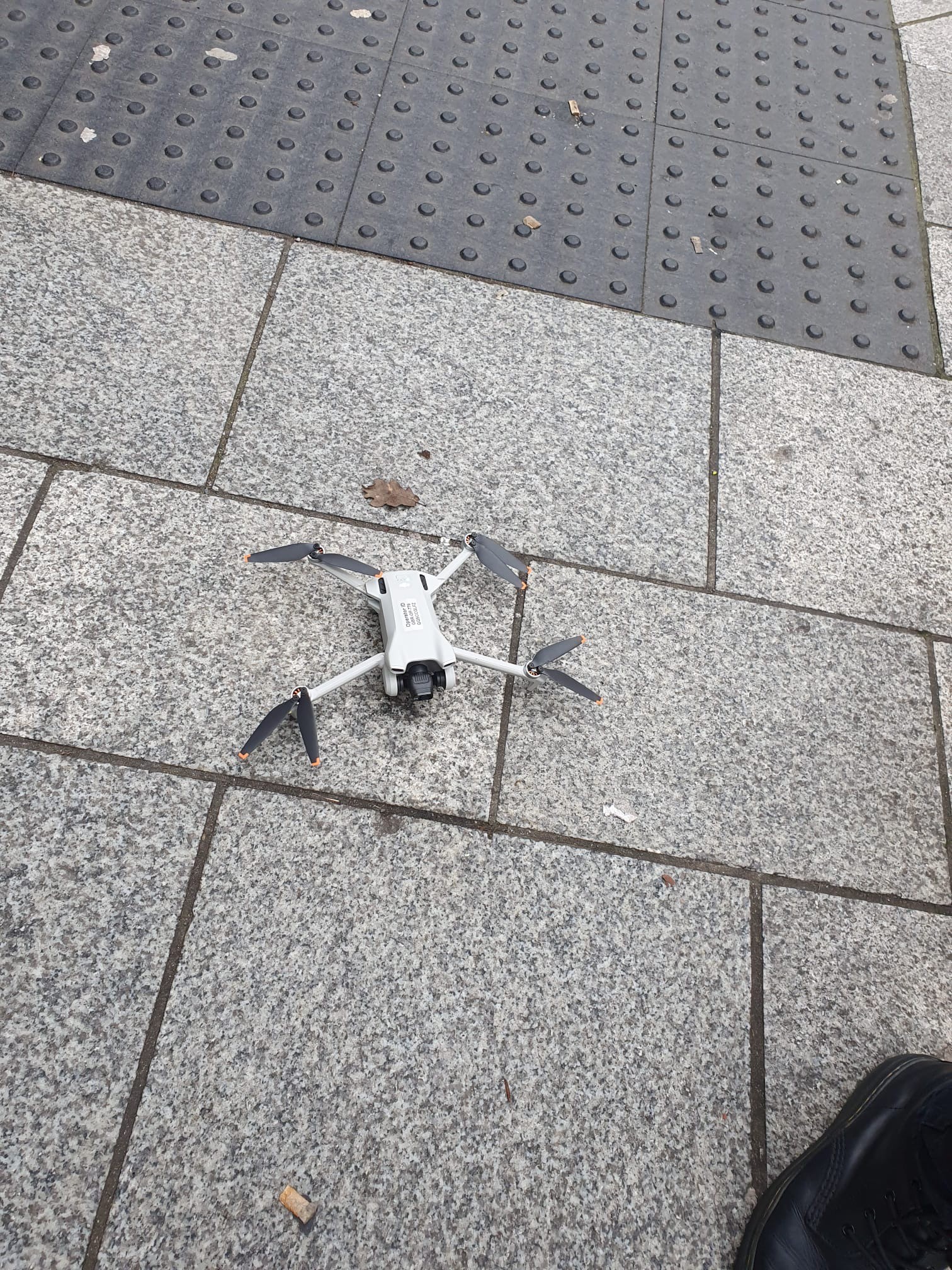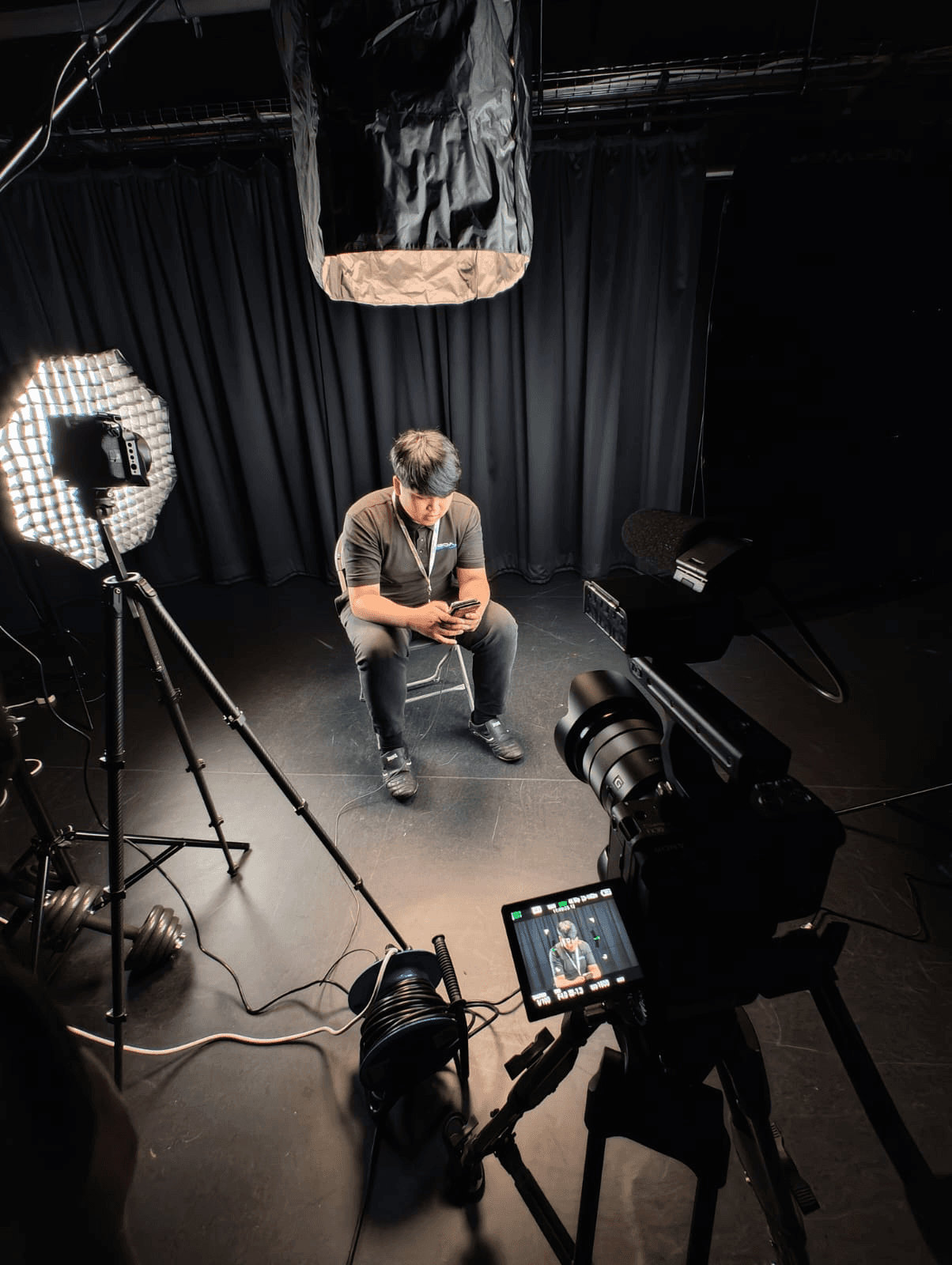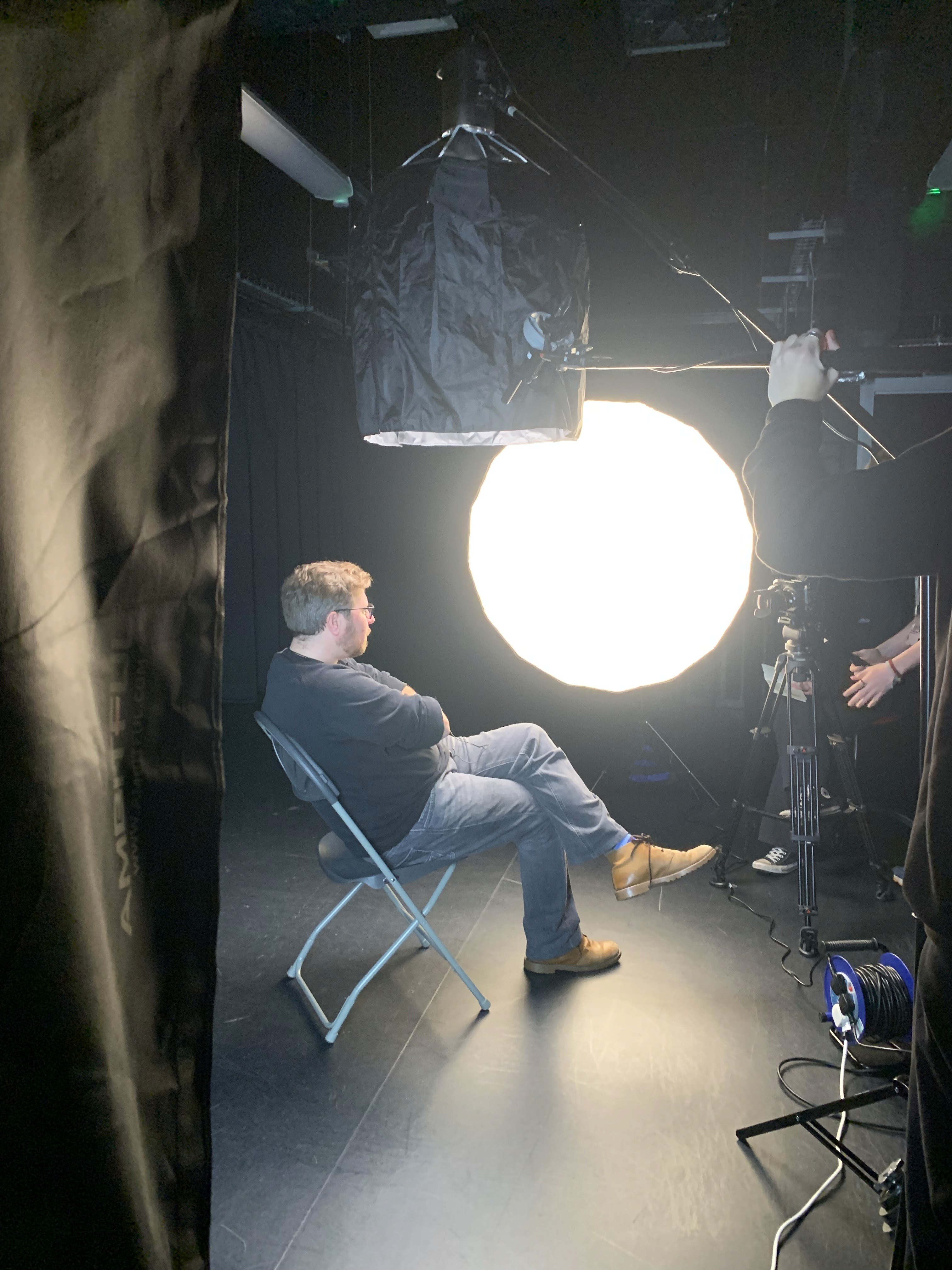Pre-Production
This is a link to a shared OneDrive folder including call sheets, risk assessments, and schedules. This was all organised by our coordinator, Gaddu, combining all of the marketing team’s pre-production into one folder.
Final Product
This is a link to a shared OneDrive folder containing all the vertical video reels I made for the Peter Pan Production
Purpose of the Project
The purpose of this project was to market and document the process of Peter Pan, a professional musical taking place at The Old Rep Theatre, a theatre owned by the same group as the school. Due to this pre-existing partnership, there were many instances of collaboration across all pathways at BOA Stage and Screen Production Academy. This provides valuable professional experience for us; from actors being extras during the actual shows, and broadcast students helming a documentary of the process, trailers of the show, and the respective marketing needed for a professional show.
For my role, I did social media marketing, as well as helping out with other content. This included interviews with the director and creative. I took photos of what it looked like behind the camera. However, my main role was the former: creating social media videos for the Old Rep Theatre. It brings further exposure of the show to an online audience, and provides a more intimate insight into how any professional theatre show, let alone this version of Peter Pan.
Brief & Client
The Old Rep Theatre was opened in 1913, and has been offering a year round catalogue of entertainment, ranging from theatre productions, stand-up sets, and creative workshops. They are also owned under the BOA trust, meaning that a fair amount of BOA students from all campuses come to work on shows together, whether that be on the stage or behind the scenes.
The Old Rep Theatre is also the exclusive home for the Peter Pan Musical for the holiday season, hence why we intend to do our marketing through the Old Rep Theatre’s social media accounts.
As people get into the festive spirit, they want to find ways they can spend precious time with their friends and family. One of these ways is to go to theatre shows, with musicals adding that extra majestic feel that comes with the winter season.
The winter season is a primetime part of the year for shows as this is where they see an increase in audience numbers. Social media allows these shows to be marketed to this increase audience which, if done effectively, should increase to a rise in audience numbers.
As the theatre is owned under the BOA trust, they work very close with BOA students on productions. Hence, marketing was done in collaboration with students from BOA Stage & Screen Production Academy, as they have the equipment and know how to film the various marketing materials, such as music videos and behind the scenes content.
My skills were needed to aid in behind the scenes content, having been working in social media marketing just over two months prior the production began. I also played a part in creating the graphics for the music video based off of one of the song’s from the musical.
Emma is the marketing manager for the Old Rep Theatre. She handles ticket sales, as well as the theatre’s social media accounts. The reason we’re working with her is that she’ll be able to accommodate our music video and social media. We request feedback or distribution through her, and she will then go on to post it online. This is why we consider her as a client, as we are doing this work to compliment her existing marketing work for the show.
The brief for this was to create two vertical videos of Peter Pan related content for the Old Rep Theatre’s social media account. Whether this was footage of rehearsals, or the behind the scenes of the set, I edited each reel to be about 16 seconds long. This would give enough time to show off the key footage, while also keeping it short enough that the audience doesn't lose interest.
Target Audience
The target audience for the social media content is adults (all genders), as they purchase the tickets, but also specifically for parents to showcase its potential as a family show. Psychographics would be people who enjoy fairytales and fantasy, whether in general or in theatre form. This is determined from the rehearsals that have taken place both at BOA Stage & Screen Production Academy and the Old Rep, and also precedes its reputation as a childhood story.
I mainly determined this target audience based off of context. As Peter Pan is well known as a childhood story, as well as having multiple big screen adaptations created with a children’s audience in mind, as well as having a look at the rehearsals as well as the content of scripts, it would be safe to say that having this catered towards children is better. However, as children do not have access to social media, we would be aiming our marketing at their parents, as they find family-friendly theatrical productions as a Christmas treat. Some people may also be particular about what sort of theatrical productions they like, as this features fantasy quite heavily.
As I wanted to cater to parents on social media, I wanted to have videos made as this would be able to capture their attention more. Just showing just the dates that the production is shown wouldn’t really make the show stand out as it does.
One of the key selling points is that it features students being both part of the cast and the crew, and showcasing this in video form would really make the show stand out as its own kind of professional production. So, I aimed to make the videos short and snappy, and showing different departments at different points of the production, whether it be rehearsal or crew on the day.
This would showcase the talent of the people behind the stage, and demonstrate how students and professionals can work in tandem to make a great show worth watching.
Representation
There are many skillsets required in the process of creating a theatre show. This not only involves actors, but also the people who work backstage, those who create the set, those who market the show, and others. With the social media content, I've aimed to get reels from these different departments. I've made reels including the main cast and ensemble during rehearsals, costumes, and creative departments who were prepping for rehearsals on opening night. It opens the audience up to the intricate care taken to make sure the show is the best it could be, whether they're professional or students.
If we were to capture solely the cast of the show, the audience would get to be familiar with people’s faces. However, with one of the main concerns of technical industries being the perception that they’re hard to break into as a young person, it wouldn’t provide that extra launchpad of interest in an industry that would appreciate more interest.
This would ring especially true for children of these parents who have an inspiration to work in a creative industry. By making these videos, I can show that it is possible for students and young people to be at the forefront of a professional theatre production. Through this, we can show to parents that these are viable industries with demand for their children to get into.
Plus, this brings a wider appreciation towards the scope of a theatre show and the sheer amount of people and time needed to bring it to life for the audience. This wider appreciation will allow them to be even more impressed at all the cool sets and practical effects that have been laid out by the students.
As such, I hope this helps the audience to consider the amount of people needed to run a show, and to hopefully see the show to see how this all works in tandem.
Through the footage, I wanted to show various parts of this production, and also maintaining a catchy editing beat through music. However, my filming also had to be as little disruptive as I could be, considering I didn’t want to get in the way of people’s performances or work. This is evident in the parts where I film what’s going on behind the scenes. I filmed as much as I could, while staying in the sidelines. A lot of care and attention was put to ensure I was dodging any sort of immediate action, and a lot of spatial awareness on my part. Similarly for rehearsals, I didn’t have too much time to film rehearsals, as we had to get prior clearance and were in at the same time as the cameraman for the main short documentary about the making of the show.
To keep consistent with the theme of magic, we decided to use the same nighttime magical background as the show’s poster, as well as the same font used in the poster, which is available in Canva’s font suite. Graphics at the start of the reel would show what the video would cover, in a similar style to the poster. Similarly, I picked the majority of music with a winter/fantasy tone in mind, and would make cuts accordingly. There was no narration in the reels, as it didn’t feel right to have someone talk over it as it would lose that indescribable magical feel with the videos as they are.
Idea Generation
Formats
Live Capture
The essence of live capture is to use a Multicam setup to record a show. This involves placing multiple cameras around the theatre, both for wide and close up shots. It reduces the need to rely on solely one or two cameras, as the vision mixer, who switches between all the feeds of footage, can switch to a camera that works if one were to malfunction. However, this cannot be overdone as it can distract from the audience experience.
It’s important to get a wide range of angles in shots, so the footage does not feel monotonous and correctly represents the atmosphere of the action. This should all be done while respecting the actors, theatre crew, and audience, so these shots can’t be too disruptive either.
It is equally important to set up audio recording correctly. It needs to be able to capture balanced audio of every key cast member, alongside audience reaction and even ensemble cast. There’s a lot of coordination required between live capture crew, theatre logistics, and everyone working on the cast to allow or a comfortable and natural experience for everyone involved. After all, this is what is eventually relayed to a remote audience.
This is a clip from the theatre performace of Hamilton on Disney+. This was recorded in around 2016. As seen in the clip, there are no shots of audience reactions. This is owing to this being a filming of a dress rehearsal. It reduces the friction process of filming in public, so seat kills to not need to be rented out. This allows for the wide range of tracked shots seen throughout the play, making it more immersive for the viewer and acts as less pressure on the cast to perform alongside a live audience too. The cast isn’t seen to look directly at the camera too, so it doesn’t appear too unnatural as if it were a performance purely for camera. There’s no distractions or any missed moments, so it all makes for a great viewing experience remotely.
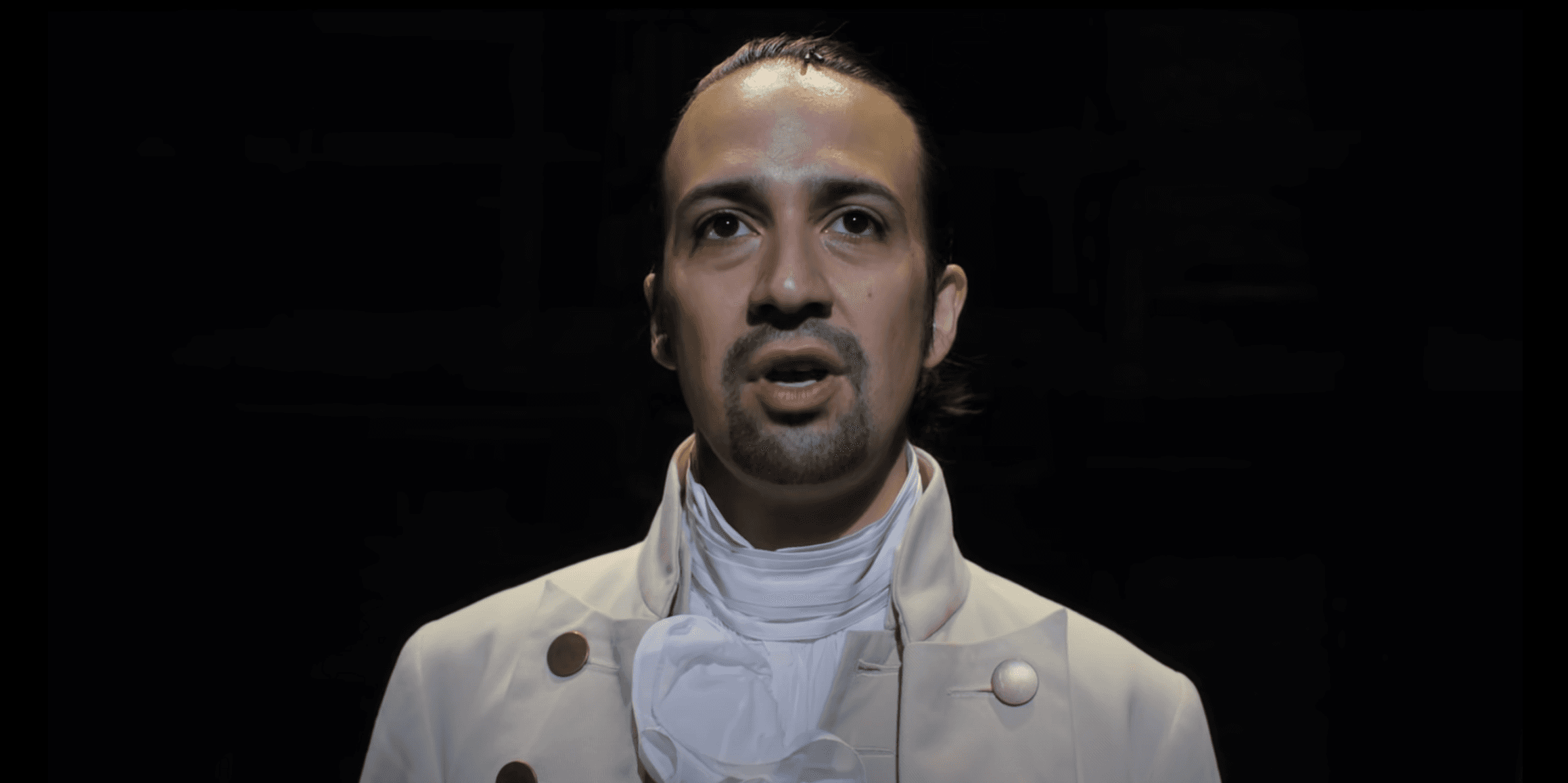
These shots are also well filmed and edited to create dramatic effect. At 16 seconds, a wide shot cuts to a mid shot of Alexander Hamilton, perfectly focused considering the lighting setup. It’s a very intimate moment, as we see the camera move slowly closer to Hamilton as he introduces himself. This actually enhances the experience for a remote viewer, as viewing angles would be entirely different (and further away) from the stage. It gives returning Hamilton viewers an opportunity to re-experience the play in a slightly different way, giving the theatre live capture purpose to exist beyond new viewers.
Theatre social media and promotional material
Most professional theatre social media, like me, touch upon various departments within the play, as well as more fun content with the main cast outside of rehearsals. This involves behind the scenes of rehearsals, prop making, costume design, and hair and makeup. Other departments may also be touched upon, but these tend to be the sorts of content you'd see on these accounts. This all has to remain consistent, so followers and other social media users can rely on the quality of output, which can contribute greatly to people’s decisions to come and watch the show.
Outside of teasers and trailers (which remains till some of the most major content that is required for a social media account), branching outside of the realms of a theatre can make for interesting crossovers that bring the show to a larger audience. An example of this could be performing a section of the show at a talent show or concert, and sharing clips of it on social media. Audience and cast interactions make the show feel more intimate, through getting to know the cast and the fans that make the show sensational. It’s this authentic passion that encourages a prospective viewer to experience it.
Promotional materials may involve posters and flyers, such as one listing all the show times for a certain period (and respective showtime availability), 4/5 star reviews featuring paraphrased opinions from well respected critical authorities, as well as other opportunities to experience the world of a play outside of the show. This could involve arts and crafts, baking, singalongs, and many more. Further promotional material can ride off of current trends, which relies on the social media marketing team to do research on other general and theatre social media trends.
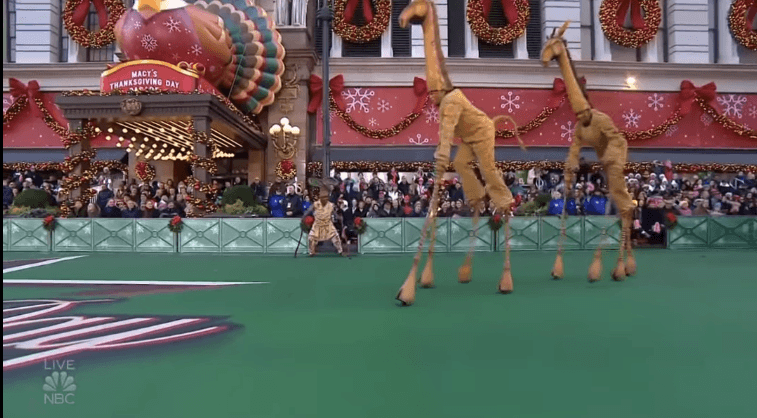
During Thanksgiving 2023, the Lion King Musical on Broadway’s social media team posted a throwback to the special performance they had done a week prior for the well-known Thanksgiving Day Parade. Especially during a national holiday, Americans would be looking for opportunities to go out for good entertainment. With the chance to perform on a large national stage with it being televised, this provides great exposure for their show.
What makes this most effective is that they perform one of the most iconic moments of the show: the opening. As a multi-cam setup displays all the various characters and background animals, it effectively sets the atmosphere for the start of the show, even considering the lack of their usual set and ambience. It’s a great strategy, as it essentially brings the show to the audience as opposed to vice-versa, which is arguably harder to do, as such is the role of a marketing team. Giving the opportunity for people to see this show up close from all angles, free from the constraints of a traditional theatre, slowly teases their interest into the show. This is what would eventually drive people to pay for tickets to see how this all plays out in action, uninterrupted, in a comfortable and non-distracted manner.
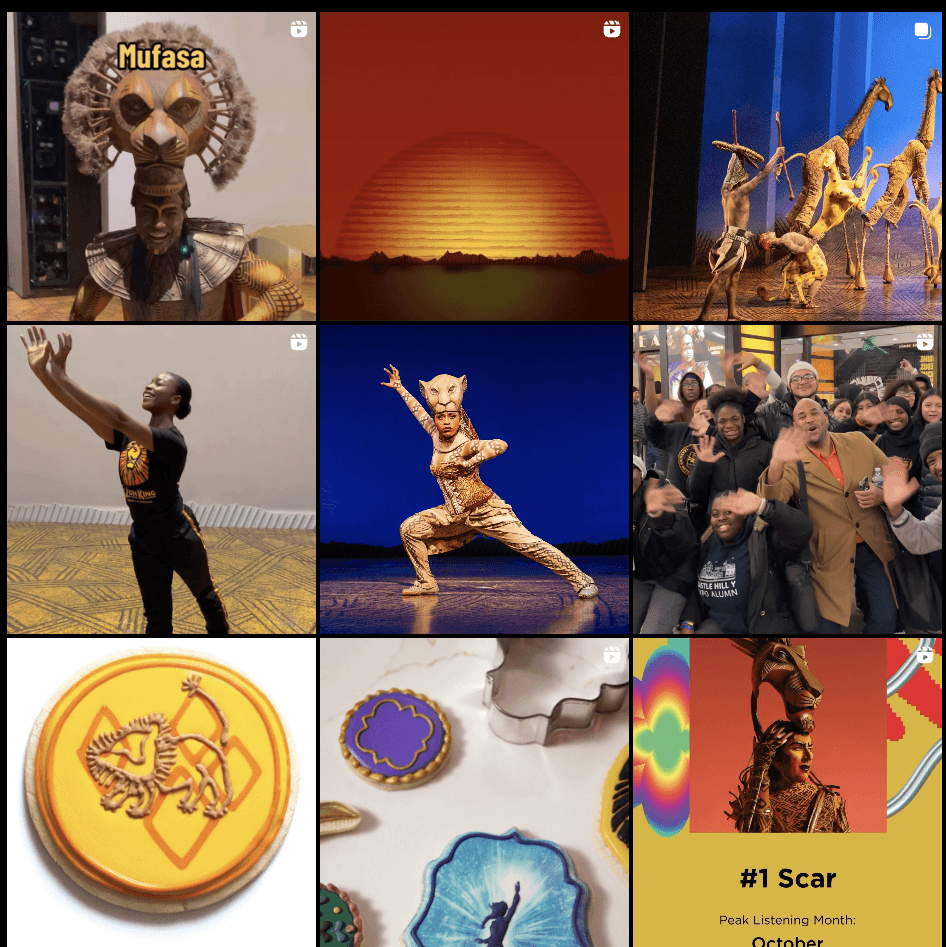
The social media account has also made additional small-scale reels and stills content. In the top left, you see a reel of the cast saying “Mufasa” in character, as we get to see the general vibe of the characters and the wide range of costumes and prosthetics they use to convey otherwise animal characters. In the top right, there is a panorama of a scene, split into three continuous photos. In the bottom right is a parody of a screenshot of a musical fan’s Spotify Wrapped, of which had been released at the time. This presents a wide variety of traditional and trendy social media content, which makes the account more accessible to everyone. It’s a play intended for the family masses, so having content that caters to everyone is important for them to achieve that. Having this fresh diversity between professional and trend content will keep people following and engaging with the account, which propagates it to larger, more general, audiences.
Matte Paintings
Matte paintings are large-scale pictures, used by both filmmakers and theatre directors, to establish an environment for a show, usually some sort of background per setting within it. They’re more commonly found in movies, however theatres have also seen these same techniques applied. This could be large-scale paintings, or digital images or projections. As theatres rely on live performances, all these effects are done live. Usually, on smaller-scale shows, this involves set designers painting set backgrounds and adding extra elements on the set according to the required setting. Larger-scale shows would see entire changes of set backgrounds, either during the performance or interval. It also offers the opportunity to create digital backgrounds and then either project them or place them on a large screen.

Brainstorming
We didn’t want to get too ahead of ourselves when we made content, so we wanted to make sure we had the basics, and that we had the basics well. This involved making a great trailer, as well as interviewing the director and key crew. A docuseries was planned, with professional cameras recording horizontals of the departments required for pre-production.
We also wanted to have an excerpt of one of the key songs filmed as a music video, in the style of a live session with the actors for Peter and Wendy alongside the composer. All these ideas meant that we could have a content dedicated towards older audience, such as parents. As they are our target audience, it provided an opportunity for them to see more how big of a part BOA students are playing in the production. It demonstrates the aptitude of everyone in their respective departments even at younger ages, whether it be the crew using professional filming equipment, or the creative pathway creating key props and sets, from scratch. It fits in with the overall aim of our marketing quite well.
All of this brainstorming took place across multiple meetings, with the entire marketing team, my coordinator, and social media marketing.
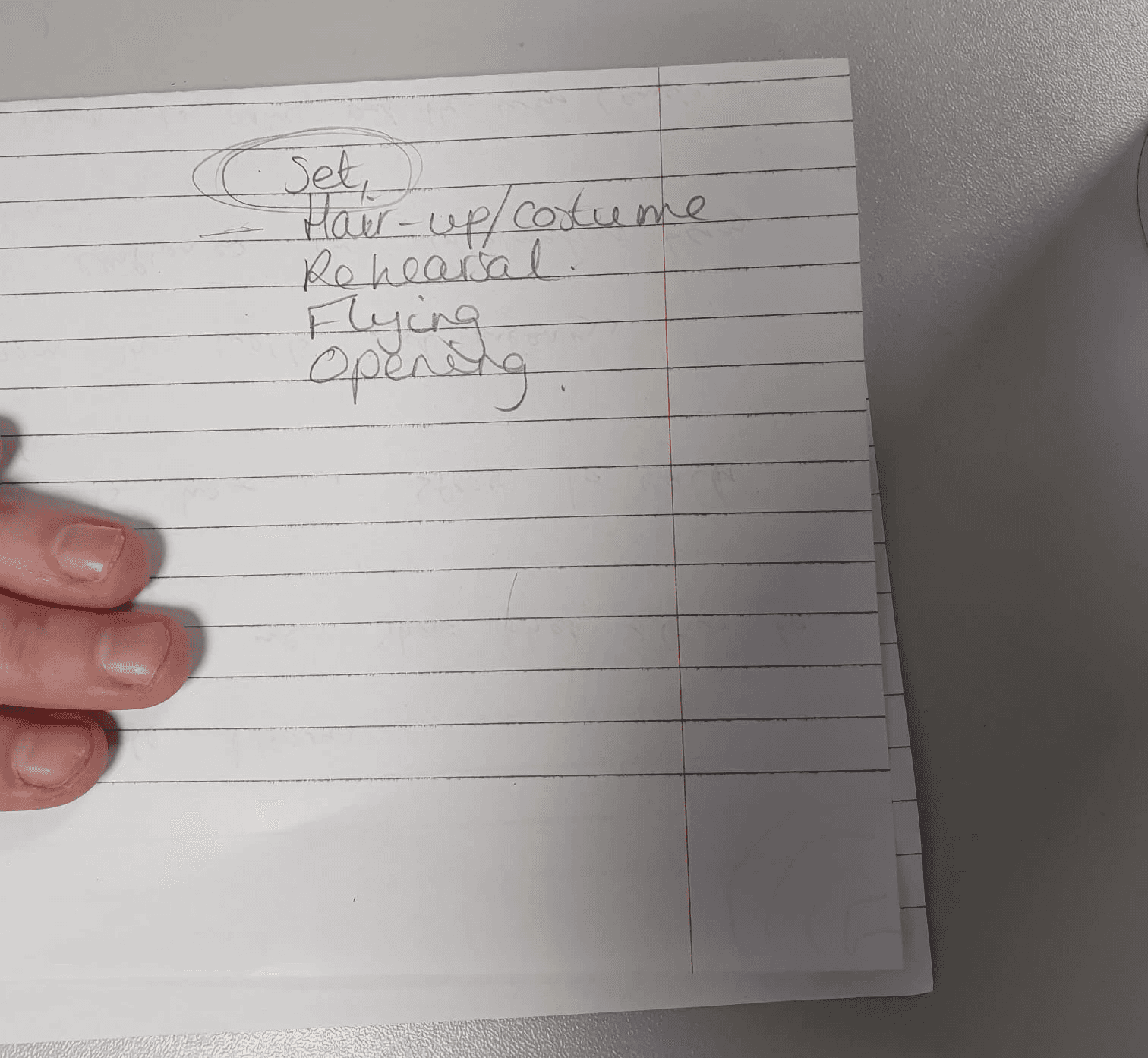
We didn’t want to get too ahead of ourselves when we made content, so we wanted to make sure we had the basics, and that we had the basics well. This involved making a great trailer, as well as interviewing the director and key crew. A docuseries was planned, with professional cameras recording horizontals of the departments required for pre-production.
We also wanted to have an excerpt of one of the key songs filmed as a music video, in the style of a live session with the actors for Peter and Wendy alongside the composer. All these ideas meant that we could have a content dedicated towards older audience, such as parents. As they are our target audience, it provided an opportunity for them to see more how big of a part BOA students are playing in the production. It demonstrates the aptitude of everyone in their respective departments even at younger ages, whether it be the crew using professional filming equipment, or the creative pathway creating key props and sets, from scratch. It fits in with the overall aim of our marketing quite well.
All of this brainstorming took place across multiple meetings, with the entire marketing team, my coordinator, and social media marketing.
Research
For our music video, I created the graphics for both the song name, as well as the final slide displaying a horizontal version of the photo alongside key information and credits. The school’s senior leadership team acted as a social media coordinator and liaison of some sort, meaning this research was done in collaboration with them.
In this case, I took inspiration from the graphics with the intro and outro of this music video made for marketing by Sheffield Theatres. This involves an opening text graphic with the song title and performers, with the ending graphics featuring the play title, showtimes, and a logo of the featured theatre at the end.
The Peter Pan musical featured a lot of talents involved, and having these graphics with the names of performers and musicians shines another light on the people that bring the music of these sorts of shows to life. Especially with credits being very important for people just getting into a creative industry, having them in the music video would also be an additional credit for the performers.
For other media products, we also looked at the examples from Hamilton and the Lion King to inform the various social media products we are making.
For example, with the release of Hamilton on Disney+, many of the marketing materials would showcase Lin-Manuel Miranda alongside the core cast, as they’re essentially the face of the production and what Hamilton is most known for. Similarly, the Lion King showed a focus on the cast in their intricate costumes. While both of these play’s marketing materials showed their spectacular as a whole, there wasn’t much in the way of stripped-down rehearsals and crew work. With the position Peter Pan is in to empower young talent on stage and screen, it was a way to show that, contrary to the glitz and glamour of the production, a lot of hard work is needed way beforehand.
We didn’t actually notice a large amount of behind-the-scenes content from the crew, so in our own way we chose to place that emphasis on talking about the amazing efforts of the crew, both young and old.
Discussion
Emma, who is the social media manager at The Old Rep Theatre, gave us creative freedom to create the content we wanted, and to send anything we make her way, with the potential for it to appear on social media. Our ideas from brainstorming remained essentially the same after correspondence from our social media coordinator who is also a BOA student. Any other ideas would come from BOA’s Senior Leadership Team for any other short-term requests.
No explicit deadlines were set with Emma, however she allowed us to get the ball rolling through providing us with a schedule for rehearsals and filming dates, alongside their respective locations. This gave me a very good idea as to when I should film the certain parts. In regards to quotas to certain part, it was very laissez-faire as to the content I could great. I had done a placement at the Old Rep Theatre with Emma for marketing, so she could trust in my ability to create good products. However, we would ensure to send any completed videos in good time.
I had an initial meeting with Gaddu, our supervisor, as well as Grace. We jotted down on a piece of paper various videos we could take, such as how the flying could be filmed and even the potential of attaching a GoPro to the actor’s chest. Ultimately, due to logistical challenges, we were not able to do this.
Most of the stuff that we filmed oriented around the schedule given to us by Emma, so we discussed the dates that we would be filming, where we should be stationed during there, and what sort of content to make.
Testing & Experimentation
Most experimentation that was taking place had either taken place as part of the documentary brief that we had been given in tandem, or on the day of filming.
One of these involves one of our team using a drone to capture an establishing shot of the exterior of the theatre. In regards to getting the actual shot, we were able to get one which looked very professional. All permits had been covered and the pilot already had great experience in drone usage.
However, there was an incident where the drone was blown onto the roof of Grand Central (which is opposite the theatre). Fortunately, after some run-ins with security and management, the drone was retrieved and sent off to be repaired.
It was definitely a case of misjudging the strength of wind, even on a relatively calm day. Other than that, the team nailed a lot of the strengths and not much really had to be revised.
Thankfully, we were still able to recuperate the shot and that has been used in establishing shots in trailers for the show, and still looks great considering the situation.
Some other tests we did were for our interview setups. As we were doing a documentary alongside this, we had essentially already been experimenting figured out our lighting and multi-cam setup. We had various studio lights, our own Sony cameras in combination with the school’s Blackmagic cameras, as well as negative fill.
With the right LUTs applied using DaVinci Resolve’s preset Sony camera LUT colours, it made for a fantastic visual, creating a clear separation between the subject and the background with deep blacks. We used this exact setup when interviewing Alec, who is the director of the play (see above, right).
The only way we could really add to that was to place coloured lights in the background to create a bit more background separation, so this is something we could do to add a bit of extra atmosphere. Besides that, our setup was as close. The final interview is shown below, where we used that interview footage with B-roll from the rehearsals.
When filming rehearsals, I took some B-roll shots of the colourful props and set pieces to add that bit of atmosphere. I also filmed scenes from the show during their run times which featured the various lighting setups, and shows depth with the black curtain in the foreground and all the exciting action in the background.
Risks & Limitations
There wasn’t much chance to isolate cast from rehearsals or during showtimes. We had already intended to mostly remain non-disruptive throughout their rehearsal and performance process, however this meant we couldn’t create more trendy content specially for viewing on a phone. This is why our initial plans mostly involved crew during pre-production, as didn’t entail as much pressure finding cast to interview than during our show time. It’s also why most of our footage taken during the shows is from the sidelines or audience perspective.
A few other problems involved mismatched interests or information that wasn’t relayed. This involved missed deadlines, and also uncertainty on the output of contact. Tightening up editing processes and communications enabled us to start to get back on top of this issue. It’s definitely taught me a lesson in communications and remaining consistent in creative output. Next time, I would change my process to make communication constant, as well as frequent check-ins between other crew so everything is on track.
As shown in the brainstorming document, we had hoped to film behind-the-scenes of how the flying process worked. Unfortunately, we were barred from doing so by the flying crew due to the confidentiality and competitiveness of their skills. We were able to proceed with all other content, and clips of flying during the actual show can still be seen in behind-the-scenes as well as publicity excerpts. Next time I would work on something like this, I now have the foresight to make availability of filming flying content a priority to obtain permissions from early on.
Another potential risk is that, during show times, I could get in the way of props or characters being moved which could affect how the show would appear on the screen. Being in the way could mean props are not on the stage in time, or it could also be too noticeable that promo content is being filmed, from the audience’s perspective. I was able to avoid this by being super aware of what was around me, and having the flexibility in my small filming setup to move at will.
Some other risks of making this promo content is that it could be almost too casual. If the content is too casual, it won’t pique people’s interest, and it would likely be relegated in their mind as an ‘amateur’ show, of which it really isn’t. So, I avoided following any specific social media trends at the time, and stuck to the formula of professional shows to provide themed insider content.
With all the issues we filmed with above, we were still able to get a good amount of content done, and it didn’t overall impact the quality of reels, but rather the potential of reels that could’ve been. Besides not being able to film the flying process, I was able to get all the sound bites and recorded videos edited to my liking.
Feedback
Most of my content didn’t require too many major changes to be made. For the aforementioned graphics I made for the music video, there were continuous small tweaks that were made, which were even done after I handed off the assets to the editor. Things like text position and fade-in length were included.
For my own social media reels, they generally didn’t ask for any additional tweaks. They are all edited to the music, containing consistent intro graphics explaining what the reel does, the video, and then fading into a Peter Pan background at the end. I created three of these: two of rehearsals, one of costume fitting, and another of rehearsal prep at the theatre.
In fact, I would give my own criticisms on my first reel. It wasn’t branded in the same way as the others, and also contained copyrighted music and not the best quality footage. I definitely would try to find some other copyright-free music, and use some higher quality shots from those who filmed the docuseries on the show. This is advice that I took into creating the next rehearsal reel, which definitely made the reels look a lot more professional.
Most feedback came from missed deadlines and miscommunication, so I definitely see this as a thing to improve on for future projects, especially when there’s so many departments and people working on something that would initially seem as simple as social media marketing.
I made these small changes as it was essentially client feedback. When working with a client, it’s important that you accommodate their wishes with the edit. There may also be some cases where new ideas for editing come about in later reels, and going back to adjust the older ones means that all the materials are kept consistent. This means that this overall project can see a similarity in their continuity, and that it’s not so disjointed from different marketing that an individual reel stands out too much.
Equipment
As I was doing a more run-and-gun social media setup, I used my personal iPhone XS as a camera in vertical and a DJI Osmo Mobile 3, which is a smartphone gimbal. This gimbal allows for stable footage compared to the typical in-camera shakiness. I used this to my advantage whenever I was filming the Peter Pan Content. It makes the camera appear a bit more 'floaty', almost like a drone shot. This almost resembles the flying aspects seen within the production, as if Tinkerbell were behind the scenes with a camera.
I put emphasis into making slow yet grand movements with the gimbal, which made the footage feel both smooth and dynamic. Especially during showtimes and rehearsals, it's important to stay out of the way and, thus, minimize movement during filming. After all, as a social media marketer for theatre, the majority of the job is acting as a fly on the wall.
The equipment setup was quite simple, as I simply had to clip the gimbal onto my phone and centre it to ensure the gimbal would function properly. This process would only take about a minute to complete. It would have to be redone every time the phone was taken off the gimbal.
As setup was quick and simple, I was able to get filming done a lot faster, and didn't have to worry about making additional adjustments during filming. The gimbal battery is also really good, meaning I didn't have to charge it at all during filming. With so many tight passageways within the theatre, it made it a very portable setup.
The only thing that didn't really go so well was video quality. As I was using my phone in lowlight, there is a fair amount of unwanted grain within the final footage. This couldn't really be fixed by lights, as it would disturb the cast and crew. Regardless, the grain would still appear due to the degraded quality of my phone's camera.
With so many instances of having to stay where I was to give way during performances, I was able to get creative with the shots I was getting, even if I was staying the same place most of the time. I experimented with different camera movements, mostly peeking through curtains and doing fake fly-through shots of back stage. In this case, I learnt a fair amount on staying on your feet; maintaining attention on both the camera and the people around me.
Software
I used multiple pieces of software to aid in creating these marketing materials for the Peter Pan production. My main software for editing the videos was DaVinci Resolve. After any filming days, I would organize each clip by day on my SSD, and then import them into Resolve. Using Resolve's “Bins” function, I sort each reel's footage into a folder alongside a dedicated timeline for it.
For text graphics, such as titles, I used Canva. This is also because the desired font for the Peter Pan logo design is only available on Canva. I liaised with our teacher who is the social media coordinator to organize assets. This included the font, backgrounds, and shadow of Peter Pan. For the reel intros, I would take the existing starry background in DaVinci, and overlay it with the title of the video in the production's font using a green screen on Canva. I would chroma key this in DaVinci to make the green screen transparent.
There was a special instance in which I created graphics for the music video created. For this, I had to take inspiration from other musical videos, more specifically from Sheffield Theatre's production of “Miss Saigon”. There would be introductory text that faded in with information on the song, performers, and composer. After the song ends, the footage fades into a horizontal version of the production poster with information on performance dates and any other credit info.
It helped with improving my workflow between Canva and DaVinci Resolve, as I was able to organize these files through the Bins function from my browser's downloads to ensure the clips remain linked for the next instance I edit.
Feedback
For the music video graphics, there was a fair amount of back-and-forth in terms of changing graphic placement with my coordinator. This allowed us to create a text hierarchy of some sorts, so we knew which text to make larger, how to position it, and what to place it on top of. I added more shadow to the original poster to make the text more readable, especially with the font choice. These were just instances of small iterations.
I did not create any rough cuts, given these social media reels are more casual videos and thus did not have a crazy amount of editing done to them. I was able to get them completed relatively fast, taking about an hour per reel. This included sourcing music and file organisation too. Some feedback given by my coordinator stated that, for the most part, the videos are edited well. It's quick and, combined with the music, captures the engagement of the audience so no retention is lost.
Roles and Responsibilities
As I was part of the social media marketing, there was not too much differentiation with crew roles. Some were camera operators, some were editors, and some were coordinators who would liaison with our professional client (The Old Rep Theatre). For my role, I did a mix of camera operating and editing. For the camera operating, I wasn’t using a professional shoulder rig with a super high-quality camera.
As mentioned earlier, I just used my phone and gimbal to record any rehearsal and show footage, whether this be at BOA Stage & Screen Production Academy or at the Old Rep Theatre. It was my responsibility to capture this footage, while being as unobtrusive as possible to make sure I wasn’t disturbing any rehearsals. It was even more important when I went to film a live show, especially with so many cast and crew bustling at the sides, which is where I was situated.
I also had my responsibilities in the post production process, for which I edited the content that I had filmed. This involved placing them into my editing software, creating appropriate edits, and then having them uploaded to a OneDrive folder in a timely manner, which could then be sent over to the Old Rep Theatre’s social media manager.
I mainly communicated with Gaddu, who acted as the coordinator for all the social media content. Through in-person discussions, we did this to arrange filming dates, times, locations, as well as what sort of content would need to be filmed. This was a similar case for Grace, who I had also been working alongside for social media marketing. Grace also communicated with the Old Rep Theatre to ensure they had the social media content they needed, and would communicate in-person and via email to check in on requested materials and make sure they’ve been sent.
I also had some communications with Mr Latham, my teacher who was offering feedback for the Peter Pan music video. As I created the intro and outro graphics for this video, he would working alongside me in-person to overlook my designing process, and suggest changes as they happened.
Here are the skills I needed to use:
Technical Knowledge
I had the technical knowledge needed to operate a phone gimbal setup, all while moving around while focusing on the viewfinder such as during showtimes. This means that dynamic shots can be made, while leaving enough space for the cast and crew to do their work.
Communication
With so many people and content demands within this marketing operation, it was key to maintain a consistent output of communication, and hence output of content. This is something that I would be doing both in-person and via email. It meant that required materials were sent to the right people, and that the right changes were made to videos to represent the product more accurately.
These are the skills that I learnt, and developed them as the marketing process went on longer. It was such a new experience at the start, so I was naturally able to develop my abilities over time. I was able to nail the expected atmosphere of the social media videos as I made more of them, while I learnt the increasing need for efficient communication as we got closer to the show dates. In the real world, these are two skills that are highly sought out within a marketing department, so working on this professional project gave me the chance to see a preview of this.
Professional Behaviour and Language
As this show was created in tandem with professionals, acting as such wasn’t a suggestion, but rather quite necessary. Whenever doing an interview with key show producers, after having pulled them out of rehearsals for a little bit, we would keep any communications clear and concise, so as not to keep them out of rehearsals for any longer than needed. This also extended to the other people I was filming with too, so that we would be clear on the shots that needed to be taken and how that was meant to be done.
During the review process for any graphics I worked on, clear communication was maintained so that I would represent required changes correctly, and that I would be able to justify my edits properly.
Other use of professional language used was emails, with which I would use to email other co-workers on any shots or bits of content I required, as well as to catch them up with all the work that I was able to complete.
Organisation
To organise and manage myself, I would first talk to my coordinator to understand what content I needed to have filmed. On most occasions, I would be filming alongside them; getting planned shots and any extra shots that would also contribute to the filming. At the soonest opportunity, I would transfer all the footage from my phone to my personal SSD, and organise it into folders. This would also give me the opportunity to source royalty-free music, which would also be organised in the other folders.
Outside of the post-production process, I ensured discipline whenever interacting with others in rehearsals, namely being respectful of people’s space and time. It got rather chaotic during show times, so I was always wary of the people moving around me.
Call sheets and schedules were not made. As I was doing filming independently of Grace, it was only really me who needed to know the times for when I had to be there. Furthermore, because the schedules for filming came from Emma herself, there was no need to create another schedule, and clearance for filming had already been given prior, and this would’ve shown up in the schedule.
Grace and I split our video responsibilities across two forms: her doing horizontal videos, and me doing vertical. This meant that our output of videos would be faster, as we wouldn’t have to rely on video assets from the other person to create certain reels. We also organised our content output such that I could have two vertical reels each week. We would ensure this has happened through email confirmations and reminders.
Audience Impact
The thing that makes this production different to other Peter Pan productions is the more intimate environment, however one that still maintains that magical feeling. Through my intentional camera movements and editing, I was able to convey that through my various reels. Many people are involved in the creation of a production, and I was able to extend this magic feeling to the pre-production process. It shows the audience that the musical is being prepared with care and detail, which would entice people to see how this all culminates together into a theatrical experience.
This also carries over into the appeal towards my target audience, which was aimed towards families. Children may not know much about what goes on behind the scenes to their favourite theatre shows, so that opportunity to see how their characters prepare for the stage can get them excited to see them in person.
As it’s a smaller production, it could make parents concerned that the show wouldn’t match the same entertainment value as larger ones, especially with students working on the production. My marketing materials, as well as all other ones produced, disprove that potential thought. With all the sets and props and characters are produced and played by students, and the students that also make the marketing, it reassures parents that the show’s quality is hardly different from a fully professional show.
When filming from the sidelines during the show, the camera angle acts like a ‘peak behind the curtain’, showing the side means that audiences can get a rough gist of what’s going on the stage, but also teases them as to how it actually looks from the front.
All shots were made by attaching my phone to a gimbal, meaning the image would be steady during movement. In keeping with the magical theme, it’s as if the viewer is ‘floating’ and overseeing the production. Any camera shake would otherwise make it hard for the viewer to focus on what’s happening, so smoothing this movement out means they can focus solely on the content.
For music, I used a mix of trending music and also winter music. I used music by Kenya Grace for the rehearsals, which is already familiar to most as a shorts sound. It shows a general understanding of social media content, and makes the video feel more familiar to the audience in its vibe. For costume fittings, I used winter morning music, with its happy-go-lucky and flitting feeling making for a comfortable and fun experience seeing the actors embrace their characters through their costumes.
As other social media content is present on the Old Rep Theatre’s accounts, I used graphics at the start featuring the show’s logo, the magical background from the posters, and what the reel features in the same font as the logo. It maintains continuity, and it immediately shows to the audience that the reel is Peter Pan-related, and may click through if they’d already stumbled across one of them.
Relation to Purpose
This project does meet the criteria set in the purpose and brief, which was to market and document the process of the creation of Peter Pan the Musical. The content was diverse, as I covered different areas and departments of the production in each reel. As such, I was also able to meet my original intentions of having a variety of on-screen action. I was able to make double the reels I originally intended.
As is in the codes and conventions of theatrical productions, I produced production content for theatre social media, in the ideal vertical format for social media and short duration to maintain engagement. This increase in engagement is what brings awareness of the show to a larger audience, which in turn increases turnout to shows in person.
Unfortunately, the music video was the only product with my contributions that was posted on the accounts. Seeing from their perspective, I understand that they would want to prioritise the horizontal reels, given they were filmed with professional cameras and also featured interviews for cutaway shots. There was also an overlap in the topics mentioned in the reel, such as rehearsals. However, the music video did perform very well on their social media, reaching around 5700 views, with the horizontal reels at about 3000 views. Both types of videos performed really well, in comparison to the average 1000 views other Old Rep marketing videos get. Numerous people liked the posts, with engagement from BOA students, Peter Pan cast, and external parties in the comments sections of these videos.
These stats are coming from Instagram. Given that people within the 18-34 age range account for 60% of Instagram’s traffic, it’s the most appropriate social media platform as it aligns with the intended target audience for the marketing content. It offers an easy place for people to view photos and videos within one app, and the ease of sharing reels with other people means that engagement is more easily done, compared to apps like TikTok or X (Twitter).
Platform & Distribution
I exported each reel in 9:16, 1080p & H.264, 25fps. This is the most widely available video format, and also is the ideal compression rate for social media to allow for quick loading. As the videos were natively recorded in 1080p, upscaling it to a higher resolution would not be of much use, and could potentially make the video look worse. H.264 is much more common than H.265. So, while having a slightly larger file size as a result, it will be accessible from every social
The main social media platform for these reels are Instagram, however also have the potential to be placed on TikTok or YouTube Shorts. I would not be the one posting these; a link to the OneDrive folder containing my finished reels will be emailed to the Old Rep Theatre’s social media manager. She will then consider posting them onto the theatre’s respective social media platforms.

